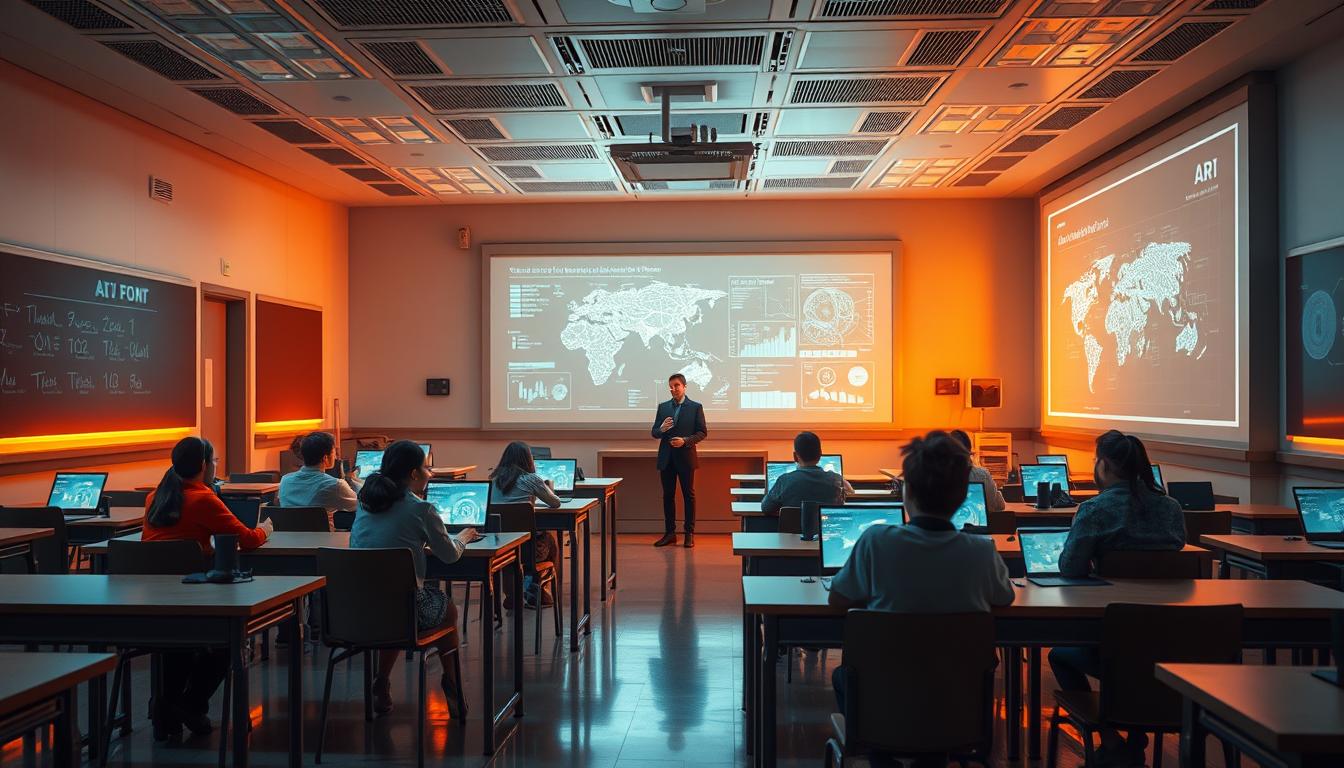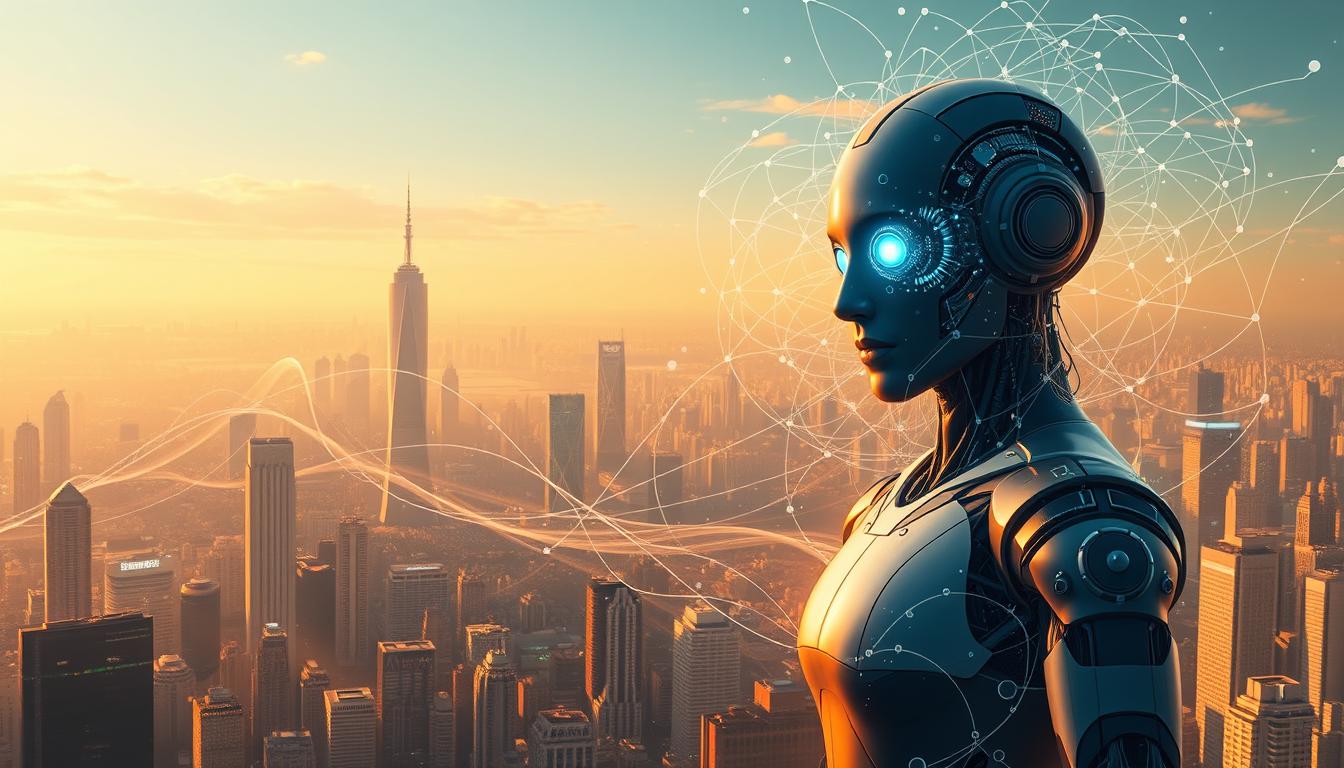
The rapid advancement of artificial intelligence is transforming the job market, leaving many to wonder if their profession is at risk.
As we approach 2025, the human vs. machine debate is becoming increasingly relevant. While AI has the potential to automate many tasks, it’s also creating new opportunities for workers to develop skills that complement technology.
The key question is: will AI replace human workers, or will it augment their capabilities? Understanding the impact of AI on employment is crucial for individuals, businesses, and policymakers.
Key Takeaways
- The job market is undergoing significant changes due to AI advancements.
- AI is creating new opportunities for workers to develop complementary skills.
- The future of work will depend on the ability to adapt to technological changes.
- Understanding AI’s impact on employment is crucial for individuals and businesses.
- The human vs. machine debate is becoming increasingly relevant in 2025.
The Current State of AI Technology
As we approach 2025, AI technology continues to advance at an unprecedented rate, transforming various aspects of our lives and industries. The current landscape of AI is characterized by significant breakthroughs and ongoing challenges.
Recent Breakthroughs in AI Development
Recent years have seen substantial advancements in AI, particularly in areas such as natural language processing and machine learning. Technologies like deep learning have enabled AI systems to perform complex tasks, from image recognition to generating human-like text. For instance, AI-powered chatbots are now capable of handling customer service inquiries with a high degree of accuracy.
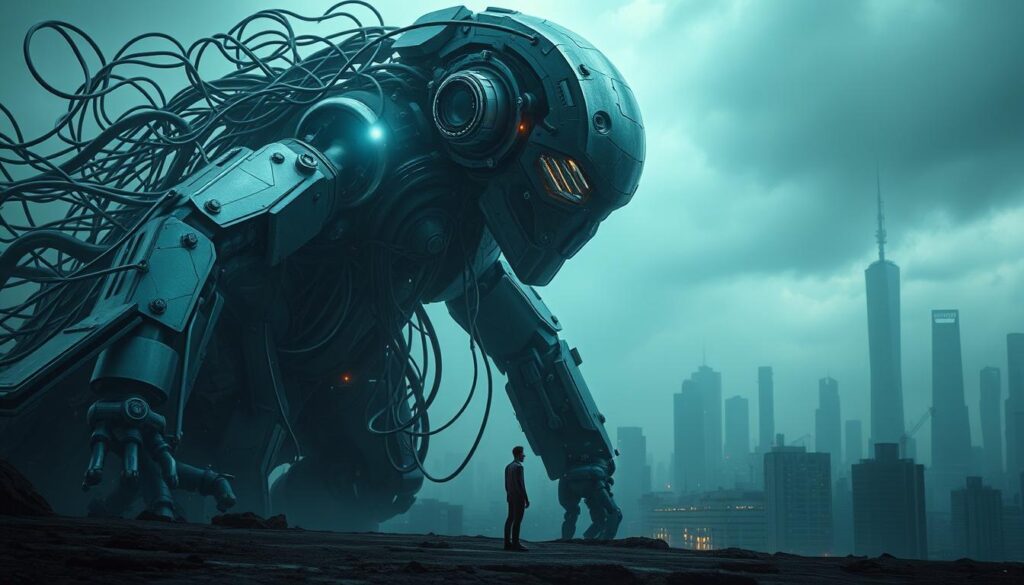
Limitations of Today’s AI Systems
Despite these advancements, current AI systems have limitations. They often lack common sense and contextual understanding, which can lead to misinterpretations or inappropriate responses in certain situations. Moreover, AI systems are heavily dependent on the quality and quantity of the data they are trained on, which can introduce biases and limitations in their decision-making processes.
The Rapid Evolution of AI Capabilities
The rapid evolution of AI capabilities is transforming the landscape of work and daily life. As AI technologies continue to advance, we can expect significant changes in how humans interact with machines and how tasks are performed across various industries.
Projected AI Advancements by 2025
By 2025, AI is expected to make substantial progress in several areas. Some of the key advancements include:
- Enhanced machine learning algorithms capable of handling complex data sets
- Improved natural language processing, enabling more sophisticated human-AI interactions
- Increased adoption of AI in industries such as healthcare, finance, and transportation
These advancements will likely lead to increased efficiency and productivity, but also raise important questions about the future of work.
Key Technologies Driving AI Growth
The growth of AI is being driven by several key technologies, including:
Machine Learning Innovations
Machine learning continues to be a crucial driver of AI advancement. Recent innovations have focused on developing more sophisticated algorithms that can learn from complex data sets.
Natural Language Processing Developments
Natural Language Processing (NLP) is another area where significant progress is being made. NLP enables machines to understand and interpret human language, facilitating more natural human-AI interactions.
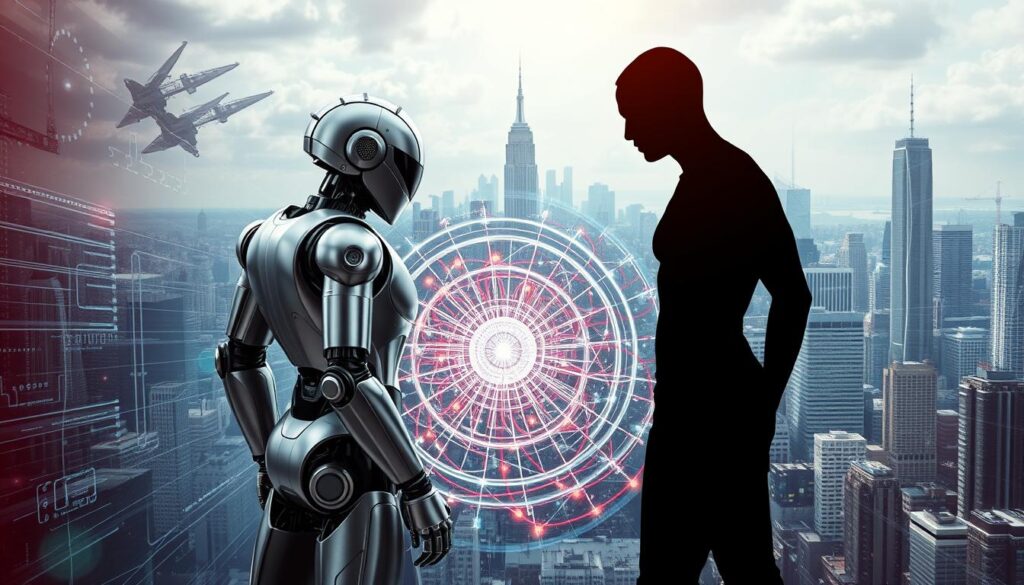
As AI continues to evolve, understanding the dynamics between ai vs. human intelligence and human vs. ai performance will be crucial for leveraging these technologies effectively.
Industries Most Vulnerable to AI Disruption
With AI becoming increasingly sophisticated, certain industries are more vulnerable to disruption than others. The impact of AI on various sectors is a topic of significant interest as we approach 2025.
Manufacturing and Production
The manufacturing sector is one of the most susceptible to AI disruption. Automation and robotics are being increasingly adopted to improve efficiency and reduce costs. According to a report by the McKinsey Global Institute, up to 800 million jobs could be lost worldwide due to automation by 2030.
“The factories of the future will be highly automated, with AI playing a crucial role in predictive maintenance, quality control, and supply chain optimization.”
Transportation and Logistics
The transportation and logistics industry is another area where AI is expected to have a significant impact. Self-driving vehicles and drones are being tested and implemented, potentially reducing labor costs and increasing efficiency. A study by Deloitte suggests that the adoption of autonomous vehicles could lead to a reduction of up to 70% in labor costs for the transportation industry.
| Industry | Potential AI Impact | Estimated Job Loss |
|---|---|---|
| Manufacturing | Automation, Robotics | Up to 50% |
| Transportation | Autonomous Vehicles | Up to 70% |
Customer Service and Retail
AI-powered chatbots and virtual assistants are transforming the customer service landscape. While this shift may lead to job losses in certain areas, it also creates opportunities for more personalized customer experiences. A report by Gartner predicts that by 2025, more than 85% of customer interactions will be managed without a human customer service representative.
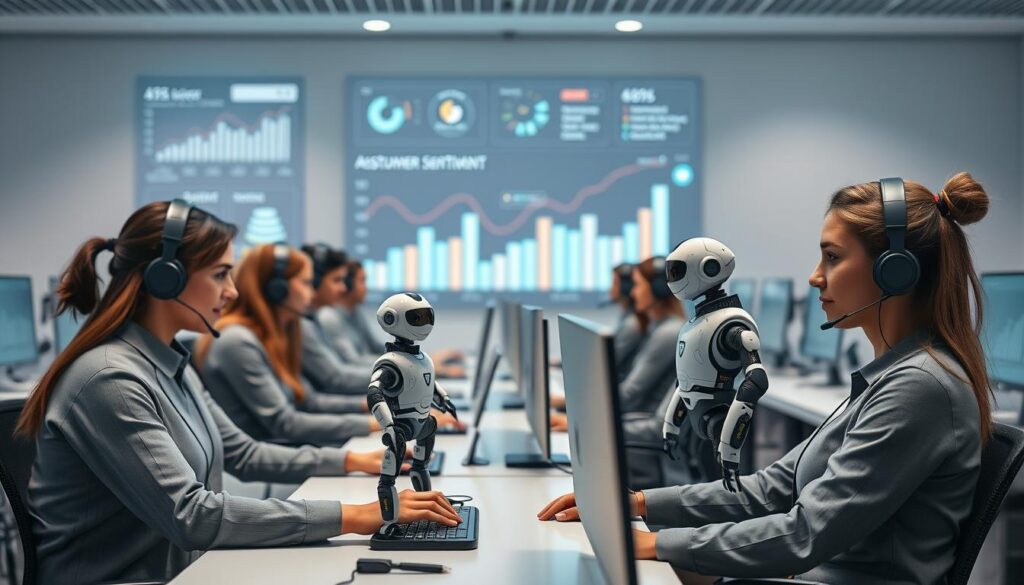
The integration of AI in these industries highlights the need for workers to adapt and acquire new skills to remain relevant in the job market.
Jobs at Highest Risk of Automation
With AI capabilities expanding rapidly, it’s crucial to identify which jobs are at the highest risk of being automated. As we approach 2025, the impact of artificial intelligence on the job market is becoming more pronounced.
Routine and Repetitive Task Roles
Jobs that involve routine and repetitive tasks are particularly susceptible to automation. Manufacturing line workers, data entry clerks, and assembly line workers are examples of roles that could be significantly impacted. AI systems can perform these tasks with greater speed and accuracy, reducing the need for human labor.
Data Processing and Analysis Positions
The increasing capability of AI to process and analyze large datasets is putting jobs in this category at risk. Data analysts, financial analysts, and market research analysts may see their roles evolve as AI takes over more routine data processing tasks. However, human judgment and interpretation will still be essential in these fields.
Entry-Level Administrative Functions
Entry-level administrative roles, such as receptionists, bookkeepers, and scheduling coordinators, are also vulnerable to automation. AI-powered virtual assistants and automated scheduling systems are becoming more prevalent, potentially reducing the need for human administrative support.
Understanding these risks is crucial for both employees and employers to prepare for the changing job landscape. By identifying the jobs most at risk, we can begin to develop strategies for reskilling and adapting to the new technological reality.
Human vs. AI: Comparative Strengths and Weaknesses
As we navigate the evolving landscape of artificial intelligence, understanding the comparative strengths and weaknesses of humans and AI becomes increasingly crucial. This comparison is not about pitting humans against AI, but rather about identifying how each can complement the other in various contexts.
AI Advantages in the Workplace
AI systems have several advantages in the workplace, primarily due to their ability to process information quickly and accurately.
Speed and Efficiency
AI can perform tasks at a much faster rate than humans, especially when dealing with large datasets. This speed and efficiency enable businesses to automate routine tasks, freeing up human resources for more complex and creative work.
Scalability and Consistency
Unlike humans, AI systems can scale to meet increasing demands without a decrease in performance. They also maintain consistency in their output, reducing the likelihood of errors that can occur due to human fatigue or oversight.
Uniquely Human Capabilities
Despite the advancements in AI, there are certain capabilities that humans possess which are currently beyond the reach of AI systems.
Emotional Intelligence
Humans have the ability to understand and manage emotions, both their own and those of others. This emotional intelligence is crucial in roles that require empathy, negotiation, and complex social interactions.
Creative Problem-Solving
While AI can process and analyze vast amounts of data, humans excel in creative problem-solving. The ability to think outside established patterns and come up with innovative solutions is a uniquely human trait.
As highlighted by Andrew Ng, a prominent AI researcher, “AI is quite good at tasks like image recognition but is not as good at tasks that require complex reasoning or common sense.” This underscores the importance of understanding the strengths and limitations of both humans and AI.
| Capability | Human Strengths | AI Strengths |
|---|---|---|
| Data Processing | Limited capacity | High capacity |
| Emotional Understanding | High capability | Limited capability |
| Creative Problem-Solving | High capability | Limited capability |
Industries Where Humans Will Maintain Advantage
Despite the rapid advancements in AI, some industries will continue to rely heavily on human intelligence and capabilities. The unique qualities that humans bring to certain fields ensure that while AI can support and augment human work, it is unlikely to fully replace the nuanced and complex contributions of human professionals.
Creative and Artistic Fields
Creative industries such as art, music, literature, and design require a level of originality, emotional depth, and personal expression that AI systems currently cannot replicate. Human creatives bring their experiences, emotions, and perspectives to their work, crafting pieces that resonate with others on a deeply human level.
- Artistic endeavors like painting and sculpture
- Musical composition and performance
- Literary writing and poetry
As Andrew Ng, AI pioneer, once noted, “AI is like electricity. It’s a powerful technology that can be used to augment human capabilities, but it’s not a replacement for human judgment and creativity.” This is particularly evident in creative fields where the human touch is irreplaceable.
Complex Social Interaction Roles
Professions that involve complex social interactions, empathy, and understanding human behavior are areas where humans will continue to excel. Roles in counseling, social work, and healthcare require a level of emotional intelligence and interpersonal skill that AI systems lack.
- Counseling and therapy services
- Healthcare professionals, especially in patient care
- Social work and community outreach
These roles demand a human ability to understand, empathize, and connect with others, making them less likely to be fully automated.
The Emergence of Human-AI Collaboration
Human-AI collaboration represents a significant shift in how we approach complex tasks and problem-solving. By leveraging the strengths of both humans and AI systems, organizations can achieve outcomes that are greater than the sum of their parts.
The concept of augmented intelligence is central to this collaboration. Rather than replacing human workers, AI is being used to enhance their capabilities, automating routine tasks and freeing up humans to focus on higher-level decision-making and creative problem-solving.
Augmented Intelligence Models
Augmented intelligence models involve the strategic integration of AI into workflows to support human decision-making. For instance, AI can analyze vast datasets to identify patterns and trends, providing insights that humans can then use to make informed decisions.
A key benefit of augmented intelligence is its ability to enhance human productivity without sacrificing the nuance and judgment that humans bring to complex tasks.
Successful Human vs. AI Interaction Case Studies
Several organizations have successfully implemented human-AI collaboration models. For example, in healthcare, AI-assisted diagnosis tools help doctors identify potential health issues more accurately and quickly.
| Industry | AI Application | Human Role |
|---|---|---|
| Healthcare | AI-assisted diagnosis | Doctors interpreting AI-generated insights |
| Manufacturing | Predictive maintenance | Technicians responding to AI-identified maintenance needs |
| Customer Service | Chatbots | Representatives handling complex customer inquiries |
These case studies demonstrate the potential of human-AI collaboration to drive innovation and efficiency across various sectors.
Economic Impact of AI Adoption
The integration of AI into various industries is transforming the economic landscape. As AI technologies become more prevalent, their effects on the economy are becoming increasingly pronounced.
Productivity Gains and GDP Growth
AI adoption is expected to drive significant productivity gains, potentially leading to increased GDP growth. By automating routine tasks and enhancing decision-making processes, AI can help businesses operate more efficiently. According to recent studies, the implementation of AI could add trillions of dollars to the global economy in the coming years.
Wealth Distribution Concerns
However, the economic benefits of AI are not likely to be evenly distributed. There are concerns that AI could exacerbate existing wealth inequalities, as those who own the technology may reap most of the benefits. This could lead to job displacement and decreased income for certain segments of the population.
New Economic Models and Policies
In response to these challenges, new economic models and policies will be necessary. This could include initiatives such as retraining programs for workers displaced by automation and the implementation of policies to ensure a more equitable distribution of AI-driven wealth. The table below outlines some potential strategies:
| Strategy | Description | Potential Impact |
|---|---|---|
| Retraining Programs | Programs aimed at helping workers develop new skills | Reduced unemployment among displaced workers |
| Universal Basic Income | A guaranteed minimum income for all citizens | Mitigation of poverty and income inequality |
| Progressive Taxation | Increased taxes on AI-driven profits | Redistribution of wealth generated by AI |
Preparing Your Career for the AI Era
As we move further into the AI era, professionals must be proactive in preparing their careers for the changes that lie ahead. The integration of artificial intelligence into various industries is transforming the job market, creating both opportunities and challenges.
Skills That Will Remain Valuable
In the face of AI advancements, certain skills will continue to be highly valued. These include human-centric abilities and technical competencies.
Human-Centric Abilities
Skills that are uniquely human, such as creativity, empathy, and complex problem-solving, will remain in high demand. These abilities enable professionals to innovate, collaborate, and navigate complex social dynamics.
Technical Competencies
Proficiency in emerging technologies, including AI and data analysis, will be crucial for staying relevant in the job market. Developing technical skills that complement AI will enhance your career prospects.
Reskilling and Education Strategies
To adapt to the changing job market, professionals must be willing to reskill and upskill. This involves embracing lifelong learning and seeking out education strategies that focus on developing AI-compatible skills.
Some effective reskilling strategies include:
- Pursuing certifications in AI and data analysis
- Participating in continuous learning programs
- Developing soft skills that are complementary to AI
By focusing on these areas, professionals can ensure their careers remain resilient in the face of AI-driven changes.
AI vs. Human Intelligence: Ethical Considerations
As we navigate the complexities of AI, it’s crucial to acknowledge and discuss the ethical implications associated with its use. The integration of AI into various sectors raises significant ethical concerns that need careful consideration.
Privacy and Surveillance Issues
The increasing use of AI in data processing and surveillance technologies has sparked concerns about privacy. AI systems can analyze vast amounts of personal data, potentially infringing on individuals’ right to privacy. It’s essential to establish robust data protection regulations to mitigate these risks.
Decision-Making Accountability
As AI assumes more decision-making roles, questions about accountability arise. When an AI system makes a decision that has negative consequences, it’s challenging to determine who is responsible. Developing clear guidelines on AI decision-making accountability is crucial.
Bias and Fairness Concerns
AI systems can perpetuate and even amplify existing biases if they are trained on biased data. Ensuring fairness in AI decision-making processes is vital. This requires careful data curation and the development of algorithms that can detect and mitigate bias.
In conclusion, the ethical considerations surrounding AI vs. human intelligence are multifaceted. Addressing these concerns requires a comprehensive approach that involves technological, regulatory, and societal efforts.
Global Perspectives on Human vs. AI Performance
The integration of AI into various industries is prompting a range of regulatory responses worldwide. As the human vs. AI debate continues, countries are adopting different strategies to manage the impact of AI on their workforces.
Regulatory Approaches Across Countries
Different nations are taking varied approaches to regulate AI. For instance, the European Union has implemented the General Data Protection Regulation (GDPR), which has set a precedent for data privacy in AI applications. In contrast, the United States has taken a more sectoral approach, with guidelines varying across different industries.
As Andrew Ng aptly put it, “AI is the new electricity. Just as electricity transformed numerous industries, AI will do the same.” This transformation necessitates robust regulatory frameworks to ensure that AI benefits society while minimizing risks.
Cultural Attitudes Toward Automation
Cultural attitudes toward AI and automation also vary significantly. In Japan, there is a strong acceptance of robots and AI in the workforce, partly due to the country’s aging population and the need for technological solutions to support elder care.
“The future is not something we wait for, but something we create.” –
In contrast, some European countries have expressed concerns about job displacement due to automation. Understanding these cultural nuances is crucial for developing AI solutions that are acceptable and beneficial to different societies.
The human vs. machine debate is complex and multifaceted, requiring a nuanced understanding of both technological capabilities and societal needs. By examining global perspectives, we can better navigate the challenges and opportunities presented by AI.
Conclusion: Navigating the Future of Work
As we approach 2025, the landscape of work is undergoing a significant transformation due to the rapid evolution of AI technology. Understanding the dynamics of human vs. ai interaction is crucial for businesses and individuals to thrive in this new environment.
The future of work will be characterized by a blend of human and artificial intelligence, with each playing to their respective strengths. While AI excels in processing data and performing repetitive tasks, humans bring creativity, empathy, and complex problem-solving skills to the table.
To navigate this future effectively, it’s essential to develop strategies that foster a harmonious human vs. ai collaboration. This includes investing in education and retraining programs that focus on developing skills that complement AI capabilities.
By embracing the potential of human vs. ai interaction and understanding the nuances of ai vs. human capabilities, we can create a more efficient, innovative, and equitable work environment.


